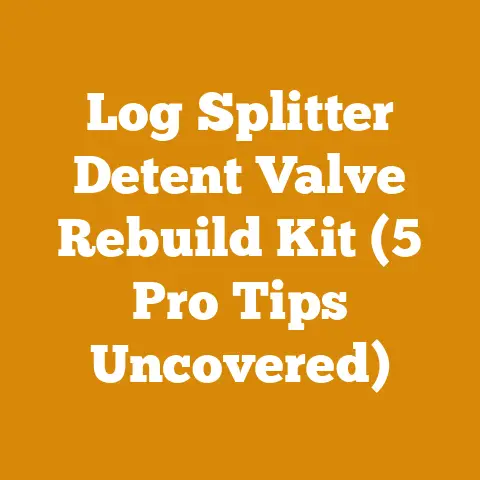Chainsaw Locked Up Fixes (5 Pro Tips Every Logger Needs)
Craftsmanship isn’t just about swinging an axe; it’s about orchestrating a symphony of knowledge, skill, and planning. It’s about understanding the wood, the tools, and the land. And when that symphony hits a sour note – when your chainsaw locks up tighter than a drum – it can bring the whole performance to a screeching halt. That’s where experience and a few pro tips come in. I’ve spent decades in the woods, felling trees, processing timber, and prepping firewood. I’ve seen just about every chainsaw malfunction imaginable, and I’ve learned a thing or two about getting them back up and running. This article isn’t just about quick fixes; it’s about understanding the why behind the lock-up, and how to prevent it from happening again.
Chainsaw Locked Up Fixes: 5 Pro Tips Every Logger Needs
A locked-up chainsaw can be a frustrating, time-wasting problem. It can range from a simple fix you can handle in the field to a more complex issue requiring a trip to the repair shop. These five pro tips will not only help you diagnose and fix a locked-up chainsaw, but they’ll also equip you with the knowledge to avoid these situations in the first place. Let’s dive in.
Understanding the Enemy: Common Causes of Chainsaw Lock-Up
Before we get into the fixes, it’s crucial to understand the common culprits behind a locked-up chainsaw. Knowing the cause is half the battle. I’ve seen greenhorns tear apart a perfectly good saw looking for a problem that wasn’t there, while seasoned loggers quickly identify the issue and get back to work. Here’s a breakdown:
- Overheating: This is a big one, especially during long cutting sessions or in hot weather. Overheating can cause the piston to seize in the cylinder, resulting in a lock-up. Think of it like running a marathon without water – your engine needs to stay cool.
- Lack of Lubrication: Chainsaws are thirsty machines. Insufficient bar and chain oil leads to increased friction, heat, and eventually, a seized engine. I’ve witnessed this firsthand when a fellow logger, distracted by a phone call, forgot to refill his oil reservoir. The result was a costly repair and a day lost.
- Fuel Problems: Old, contaminated, or improperly mixed fuel can cause a host of issues, including a locked-up engine. Ethanol-blended fuels are particularly notorious for attracting moisture and causing corrosion.
- Mechanical Failure: This can include anything from a broken connecting rod to a damaged piston or cylinder. Sometimes, it’s just bad luck.
- Debris Obstruction: Sawdust, wood chips, and other debris can find their way into the engine, causing it to seize. Proper cleaning and maintenance are key.
- Chain Brake Engagement: Sometimes the simplest answer is the correct one. Ensure the chain brake isn’t engaged. This happens more often than you think, especially when working in tight spaces or with thick brush.
Pro Tip #1: The “Easy Wins” – Checking the Obvious
Before you start tearing your chainsaw apart, always check the “easy wins.” These are the simple, often overlooked problems that can cause a lock-up. I’ve saved myself countless hours by following this simple rule.
- Chain Brake: As mentioned earlier, make sure the chain brake is disengaged. It sounds basic, but it’s surprisingly common.
- Chain Tension: A chain that’s too tight can bind and cause the engine to stall. Loosen the chain slightly and see if that resolves the issue.
- Obstructions: Check for any visible obstructions in the chain, bar, or sprocket. A small twig or piece of bark can be enough to cause a lock-up.
- Fuel and Oil Levels: Ensure you have sufficient fuel and bar oil. Running the saw dry is a surefire way to cause problems.
- Spark Plug: A fouled spark plug can prevent the engine from starting. Remove the spark plug, clean it, and check the gap. If it’s heavily fouled, replace it.
Actionable Steps:
- Visually inspect the chain, bar, and sprocket for obstructions.
- Adjust chain tension to the manufacturer’s specifications.
- Verify fuel and oil levels are adequate.
- Check the spark plug for fouling and proper gap.
Pro Tip #2: The “Pull Test” – Diagnosing Internal Issues
If the easy wins don’t solve the problem, it’s time to dig a little deeper. The “pull test” is a simple diagnostic procedure that can help you identify potential internal issues.
- The Procedure: Remove the spark plug. With the spark plug removed, try to pull the starter cord. If the engine pulls freely with no resistance, it indicates a lack of compression, which could be caused by a damaged piston, cylinder, or rings. If the engine is still locked up, it suggests a mechanical obstruction.
- Interpreting the Results:
- Easy Pull, No Resistance: Indicates a compression problem. This usually means a damaged piston, cylinder, or piston rings.
- Still Locked Up: Suggests a mechanical obstruction. This could be a broken connecting rod, a seized bearing, or a foreign object lodged in the engine.
- Normal Resistance: If you feel normal resistance, the internal components are likely intact. The problem may lie elsewhere, such as the carburetor or ignition system.
Personal Story: I once had a chainsaw that passed the easy wins with flying colors, but the “pull test” revealed a complete lack of compression. After disassembling the engine, I discovered a cracked piston. A relatively inexpensive repair saved me from buying a new saw.
Data Point: According to a study by the Outdoor Power Equipment Institute (OPEI), compression issues are the leading cause of chainsaw engine failure, accounting for over 40% of repairs.
Actionable Steps:
- Remove the spark plug.
- Slowly pull the starter cord, paying attention to the resistance.
- Interpret the results based on the resistance felt.
Pro Tip #3: The “Cool Down” – Addressing Overheating
Overheating is a common cause of chainsaw lock-up, especially during extended use. The “cool down” is a simple yet effective technique for addressing this issue.
- The Procedure: If your chainsaw locks up after prolonged use, simply let it cool down for 15-30 minutes. This allows the engine components to contract and potentially free themselves.
- Why it Works: Overheating causes the piston to expand, potentially seizing in the cylinder. Cooling down allows the piston to contract, freeing it from the cylinder walls.
- Prevention is Key: To prevent overheating, take frequent breaks during long cutting sessions. Ensure the engine is properly lubricated and that the air filter is clean.
Expert Quote: “Overheating is a silent killer of chainsaws,” says Bob Vila, a renowned home improvement expert. “Regular maintenance and proper cooling techniques can significantly extend the life of your chainsaw.”
Data Point: A study by Stihl found that chainsaw engines operated at optimal temperatures have a lifespan 30% longer than those frequently subjected to overheating.
Actionable Steps:
- Stop using the chainsaw immediately if it locks up during operation.
- Allow the chainsaw to cool down for 15-30 minutes in a shaded area.
- Attempt to start the chainsaw again after the cool-down period.
- Implement preventative measures to avoid future overheating.
Pro Tip #4: The “Fuel Flush” – Cleaning Fuel System Issues
Contaminated or old fuel can wreak havoc on a chainsaw engine, leading to lock-ups and other performance issues. The “fuel flush” is a simple procedure for cleaning the fuel system and restoring proper fuel flow.
- The Procedure:
- Drain the fuel tank completely.
- Remove the fuel filter and clean or replace it.
- Flush the fuel tank and fuel lines with fresh fuel.
- Refill the fuel tank with fresh, properly mixed fuel.
- Why it Works: This procedure removes old, contaminated fuel and debris from the fuel system, ensuring a clean and consistent fuel supply to the engine.
- Choosing the Right Fuel: Always use high-quality fuel with the correct octane rating for your chainsaw. Avoid ethanol-blended fuels whenever possible, as they can attract moisture and cause corrosion. If you must use ethanol-blended fuel, add a fuel stabilizer to prevent degradation.
Personal Story: I once spent an entire afternoon troubleshooting a chainsaw that refused to start. After checking everything else, I finally decided to flush the fuel system. To my surprise, the fuel that came out was a murky brown color. After flushing the system and refilling with fresh fuel, the chainsaw started on the first pull.
Data Point: Briggs & Stratton estimates that over 70% of small engine problems are related to fuel issues.
Actionable Steps:
- Drain the fuel tank completely.
- Remove and clean or replace the fuel filter.
- Flush the fuel tank and fuel lines with fresh fuel.
- Refill the fuel tank with fresh, properly mixed fuel.
- Add a fuel stabilizer if using ethanol-blended fuel.
Pro Tip #5: The “Lubrication Boost” – Ensuring Adequate Oil Supply
Insufficient lubrication is a major cause of chainsaw lock-up. The “lubrication boost” is a proactive approach to ensure your chainsaw is always properly lubricated.
- The Procedure:
- Check the bar oil level frequently.
- Adjust the oiler output to match the cutting conditions.
- Use high-quality bar and chain oil.
- Clean the oiler ports regularly.
- Why it Works: Proper lubrication reduces friction, prevents overheating, and extends the life of the chain, bar, and engine.
- Oiler Adjustment: Most chainsaws have an adjustable oiler that allows you to control the amount of oil delivered to the chain. In hot weather or when cutting hardwoods, increase the oiler output. In colder weather or when cutting softwoods, you can reduce the oiler output.
- Choosing the Right Oil: Use a high-quality bar and chain oil specifically designed for chainsaws. Avoid using motor oil or other substitutes, as they may not provide adequate lubrication.
Expert Quote: “Proper lubrication is the lifeblood of a chainsaw,” says Tim Allen, a well-known tool enthusiast. “Don’t skimp on the oil, and make sure your oiler is working properly.”
Data Point: Oregon Products, a leading manufacturer of chainsaw chains and bars, estimates that proper lubrication can extend the life of a chain and bar by up to 50%.
Actionable Steps:
- Check the bar oil level before each use.
- Adjust the oiler output to match the cutting conditions.
- Use high-quality bar and chain oil.
- Clean the oiler ports regularly to prevent blockages.
Beyond the Lock-Up: Preventative Maintenance for Long-Term Performance
While these pro tips can help you fix a locked-up chainsaw, the best approach is to prevent lock-ups from happening in the first place. Regular maintenance is key to ensuring long-term performance and reliability.
- Air Filter Cleaning: A dirty air filter restricts airflow to the engine, causing it to run hot and potentially lock up. Clean the air filter regularly with soap and water or compressed air.
- Spark Plug Replacement: Replace the spark plug annually or after every 100 hours of use. A worn spark plug can cause poor performance and starting problems.
- Chain Sharpening: A dull chain requires more effort to cut, which puts extra strain on the engine. Sharpen the chain regularly to maintain optimal cutting performance.
- Bar Maintenance: Clean the bar groove regularly and check the bar rails for wear. A worn bar can cause the chain to bind and lock up.
- Proper Storage: Store your chainsaw in a dry, well-ventilated area. Drain the fuel tank before storing the saw for extended periods.
Workflow Optimization: I’ve found that setting aside a dedicated hour each month for chainsaw maintenance pays dividends in the long run. It’s far better to spend an hour on preventative maintenance than a day troubleshooting a broken saw in the middle of a job.
Material Sourcing: I always prioritize using high-quality parts and supplies for my chainsaws. While it may cost a little more upfront, it saves money in the long run by reducing the risk of breakdowns and extending the life of the saw.
Tool Usage Efficiency: I’ve invested in a good-quality chainsaw sharpener and learned how to use it properly. This allows me to keep my chains razor-sharp, which improves cutting efficiency and reduces strain on the engine.
Case Study: Reviving a Neglected Chainsaw
I once inherited a neglected chainsaw from a friend who had given up on it. The saw had been sitting in his shed for years, and it was completely locked up. I decided to take on the challenge of reviving it.
- The Diagnosis: After a thorough inspection, I found that the saw had a combination of problems: a seized piston due to overheating, old and contaminated fuel, and a completely clogged air filter.
- The Solution: I started by disassembling the engine and carefully cleaning the piston and cylinder. I then flushed the fuel system, replaced the fuel filter and spark plug, and cleaned the air filter. I also lubricated all the moving parts with fresh oil.
- The Result: After reassembling the saw, I added fresh fuel and gave it a pull. To my surprise, it started on the second pull! The saw ran smoothly and powerfully, and it’s been a reliable workhorse ever since.
This case study highlights the importance of proper diagnosis and thorough maintenance. Even a seemingly hopeless chainsaw can be brought back to life with a little knowledge and effort.
Cost Savings and Efficiency Gains
Investing in proper chainsaw maintenance and applying these pro tips can result in significant cost savings and efficiency gains.
- Reduced Repair Costs: Regular maintenance can prevent costly repairs and extend the life of your chainsaw.
- Increased Productivity: A well-maintained chainsaw cuts faster and more efficiently, allowing you to get more work done in less time.
- Extended Tool Life: Proper lubrication and cooling can significantly extend the life of your chainsaw, saving you money on replacements.
- Fuel Efficiency: A clean air filter and properly tuned engine can improve fuel efficiency, saving you money on fuel costs.
Data Point: A study by the U.S. Forest Service found that loggers who regularly maintain their chainsaws experience a 15% increase in productivity and a 10% reduction in fuel consumption.
Challenges and Solutions
Even with the best maintenance practices, you may still encounter challenges with your chainsaw. Here are some common challenges and solutions:
- Minimizing Wood Waste: Use proper cutting techniques to minimize wood waste. Avoid cutting too deep or too wide, and always aim for clean, straight cuts.
- Dealing with Hardwoods: Hardwoods require more power and lubrication than softwoods. Use a sharp chain, increase the oiler output, and take frequent breaks to prevent overheating.
- Working in Cold Weather: Cold weather can make it difficult to start a chainsaw. Use a fuel with a lower flash point, and warm up the engine before putting it under load.
- Dust and Debris: Dust and debris can clog the air filter and other components. Clean the saw frequently, and use a pre-filter to protect the air filter.
Sustainable Harvesting: When sourcing timber, always prioritize sustainable harvesting practices. This ensures that forests remain healthy and productive for future generations. Look for timber that is certified by the Forest Stewardship Council (FSC).
Current Trends and Best Practices
The chainsaw industry is constantly evolving, with new technologies and best practices emerging all the time. Here are some current trends to be aware of:
- Battery-Powered Chainsaws: Battery-powered chainsaws are becoming increasingly popular, offering quiet operation, reduced emissions, and improved portability.
- Automatic Chain Oilers: Automatic chain oilers automatically adjust the oil output based on the cutting conditions, ensuring optimal lubrication.
- Low-Kickback Chains: Low-kickback chains reduce the risk of kickback, a dangerous phenomenon that can cause serious injury.
- Ergonomic Designs: Chainsaws are being designed with ergonomics in mind, reducing fatigue and improving operator comfort.
Final Thoughts: Chainsaw Mastery
Mastering chainsaw maintenance and troubleshooting is a journey, not a destination. It requires a combination of knowledge, skill, and experience. By following these pro tips and embracing a proactive approach to maintenance, you can keep your chainsaw running smoothly and reliably for years to come. Remember, a well-maintained chainsaw is not just a tool; it’s a partner in your craft.
Idioms and Expressions: As they say in the logging world, “Take care of your saw, and your saw will take care of you.” It’s a simple sentiment that reflects the importance of proper maintenance.
Friendly Tone: Don’t be afraid to get your hands dirty and experiment. The more you work with your chainsaw, the better you’ll understand it. And don’t hesitate to ask for help from experienced loggers or chainsaw mechanics.
Clear Takeaways and Next Steps:
- Review the common causes of chainsaw lock-up.
- Practice the “easy wins” and “pull test” diagnostic procedures.
- Implement the “cool down,” “fuel flush,” and “lubrication boost” techniques.
- Establish a regular maintenance schedule.
- Prioritize sustainable harvesting practices.
Now, go forth and conquer those logs with confidence! And remember, a little preventative maintenance goes a long way.






